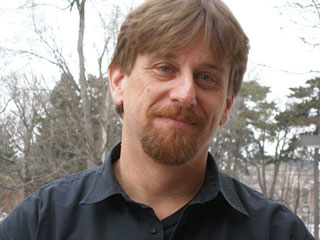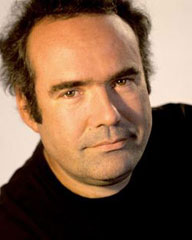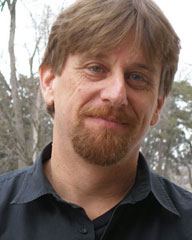

Featuring guest composer James Paul Sain
The Center for New Music Ensemble
Sunday, September 22, 2019 at 7:30p in the Concert Hall
Program
Beltà, poi che t'assenti (1611) |
Carlo Gesualdo (1566–1613) [arr. Gompper] |
Musica segreta (2006) |
David GOMPPER (b.1954) |
Luciana Hontila, violin
Donghee Han, viola
Sarah Hansen, violoncello
David Gompper, piano
Zach Stanton, conductor
Palimpseste (third version) (2002) |
Marc-Andre DALBAVIE (b.1961) |
Alexis Letourneau, flute
Ana Maria Locke, clarinet
Karina Glasinovic, piano
Luciana Hontila, violin
Donghee Han, viola
Sarah Hansen, violoncello
David Gompper, conductor
––– Intermission –––
Polestar (2017) I. Calmly
|
James Paul SAIN (b.1959) |
Kim Cassisa, clarinet
Karina Glasinovic, piano
Endopsychosis (2019) premiere I. Schizophrenia (attacca)
|
|
Alexis Letourneau, flute (picc)
Jenna Sehmann, oboe
Ana Maria Locke, clarinet (A)
Shawn Seguin, bassoon
Irene Tang, horn
Ciarra Krist, trumpet (C)
Tom Kelley, trombone
Peter Naughton, percussion
Matt Anderson, percussion
Karina Glasinovic, piano
Luciana Hontila, violin I
Joshua Palazzolo, violin II
Donghee Han, viola
Sarah Hansen, violoncello
Will Yager, double bass
David Gompper, conductor
Program Notes
Carlo Gesualdo
| Tristis est anima mea The secular madrigal Beltà, poi che t’assenti is published in the sixth book of Madrigals (1611) by Carlo Gesualdo. |
||||
|

|

Carlo Gesualdo, principe di Venosa, conte di Conza, (born March 30, 1566, Venosa [Italy]—died September 8, 1613, Gesualdo), Italian composer and lutenist. Until the late 20th century his fame rested chiefly on his dramatic, unhappy, and often bizarre life. Since the late 20th century, however, his reputation as a musician has grown, based on his highly individual and richly chromatic madrigals…. He is especially noted for what music scholar Glenn Watkins called the “dazzling harmonic style” of his last two books of madrigals ….
Gesualdo was much interested in the widespread musical reputation of the Este court in Ferrara. In 1594 he traveled there as a composer and musician and … found the atmosphere of the Este court and his proximity to several of the leading composers of the day quite stimulating. His first two books of madrigals were published by the Ferrarese ducal press in 1594. His third book of madrigals was first published by the ducal press in 1595 and the fourth in 1596, both apparently written largely during his time in Ferrara and both showing signs of the development of his personal vision ….
In 1603 Gesualdo published two sacred motet collections. Gesualdo’s last two books of madrigals (as well as a Holy Week Responsoria) were published in 1611. Although these last two books of madrigals were long considered “late” works because of their dramatic exclamations, linearly driven chromaticism, discontinuous texture, and harmonic license—that is, their generally unusual and experimental nature—Gesualdo himself claimed that they had in fact been written in the mid-to-late 1590s, near the time of his other published madrigals, and that he had been forced to publish accurate copies because inaccurate copies had been printed and some work plagiarized. —Encyclopædia Britannica, Kathleen Kuiper
David Gompper
| Musica Segreta | ||
|

David Gompper has lived and worked professionally as a pianist, a conductor, and a composer in New York, San Diego, London, Nigeria, Michigan, Texas and Iowa. He studied at the Royal College of Music in London with Jeremy Dale Roberts and Humphrey Searle. After teaching in Nigeria, he received his doctorate at the University of Michigan and taught at the University of Texas, Arlington. Since 1991, he has been Professor of Composition and Director of the Center for New Music at the University of Iowa. In 2002-2003 Gompper was in Russia as a Fulbright Scholar, teaching, performing and conducting at the Moscow Conservatory. In 2009 he received an Academy Award from the American Academy of Arts and Letters in New York City, and a Fromm Commission in 2013.
Gompper's compositions have been performed at Carnegie Hall, Lincoln Center and Merkin Halls (New York), Wigmore Hall (London), Konzerthaus (Vienna) and the Bolshoi and Rachmaninoff Halls (Moscow Conservatory). For the Naxos label, the Royal Philharmonic Orchestra recorded his Violin Concerto with Wolfgang David, and two new discs of works that include four concerti (Double, Clarinet, Cello and Double Bass), as well as three orchestral works.
Marc-Andre Dalbavie
| Palimpseste | ||
|

Composer Marc-André Dalbavie was born in 1961. After studying at the Paris Conservatory (1980-86) where he received several first prizes, he spent five years as part of the musical research department at IRCAM from 1987 to 1988, he studied conducting with Pierre Boulez. He is currently professor of orchestration at the Paris Conservatory, and composer in residence with the Cleveland Orchestra.
Starting in 1982, he and other composers of his generation became interested in the potentials of spectral music, particularly those offered by timbre and processing. He enhanced these techniques with polyphonic and rhythmic techniques (speed, metrics...), also developing formal principles of recurrence, integrating heterogeneous and spatial phenomena through his usage of electronics, as well as employing music and acoustic computer programs.
If, for him, the eighties were devoted to timbre and color (Miroirs transparents, Diadèmes...), the nineties would be devoted to space and location. The composer feels strongly about applying the concept of work in situ to musical creation, thus demonstrating the possibilities offered by the spacialization generated by orchestral composition. In Seuils, the electronic equipment is installed around the audience and the poetic text that is used makes reference to the space in which it intervenes. The use of baroque instruments links the Concertino with a 17th century piece (Curtain Tune by M. Locke). L'Offertoire for men's choir and symphony orchestra suggests virtual spaces simulated by the choral writing. In Concerto pour violon, one section of the orchestra is installed around the audience, breaking down the standard frontal concert orientation, thus redefining the very idea of a concerto. Lastly, in Non-Lieu composed with writer Guy Lelong, the stage is completely empty and the 4 women's choirs, as well as the instrumental ensemble, are distributed in the hall around the audience.
The music of Marc-André Dalbavie is published by Editions Jobert.
James Paul Sain
| Polestar | |||
|
| Endopsychosis is the “spiritual” state in which psychoses are exhibited without the traditional symptoms of the disorder. The single movement work encompasses three sections: Schizophrenia, Delusional Disorder, and Paraphrenia, followed by a codetta. The three sections of the work are each based on four different hexachords comprised substantially of cluster triads presented in various contexts and orchestrations. The codetta presents the previous musical material reconciled in the final diverging 12 hexacordal chorale. During the past year the composer has journeyed with two of his extended family members as they proceeded along the Alzheimer’s progression. Their struggles with memory and perception of reality informs the musical journey of Endopyschosis. This work is dedicated to loved ones struggling with physical and/or mental disease. |

James Paul Sain is Professor of Music at the University of Florida where he has taught acoustic and electroacoustic music composition, theory, and technology for 28 years. He founded and directed the internationally acclaimed Florida Electroacoustic Music Festival for 17 years. Sain is responsible for programming over 1700 works of contemporary art music. His compositional oeuvre spans all major acoustic ensembles, instrumental and vocal soloists, and has embraced electroacoustic music. His works have been featured at major national and international societal events. He has presented his music in concert and given lectures in Asia, Europe, South America and North America. Dr. Sain is President Emeritus of the Society of Composers Inc. He previously served for several terms on American Composers Alliance Board of Governors. His music is available in print from Brazinmusikanta and American Composers Editions and on CD on the Capstone, Electronic Music Foundation, Innova, University of Lanús, Mark Masters, Albany and NACUSA labels.